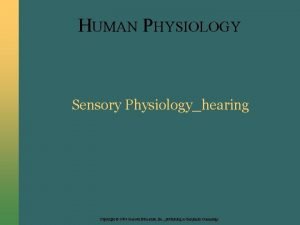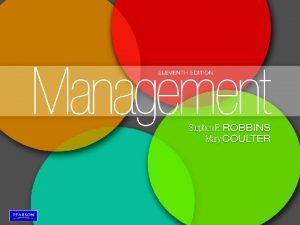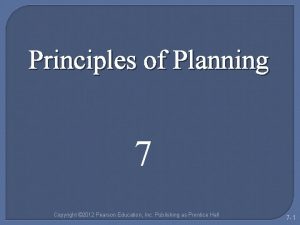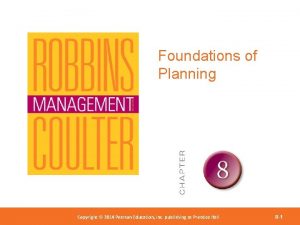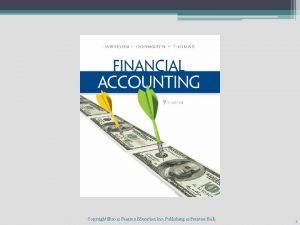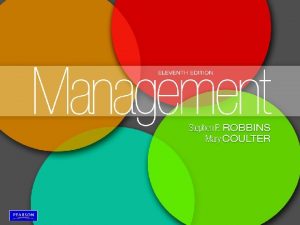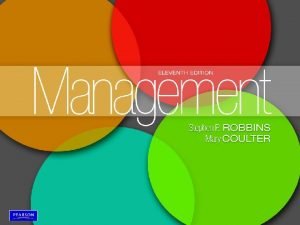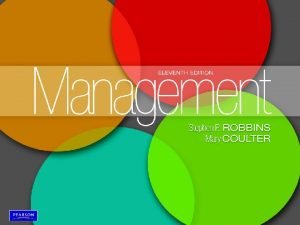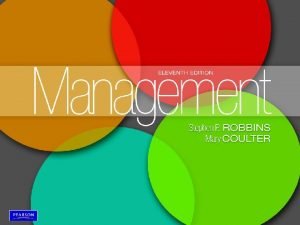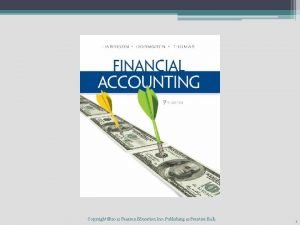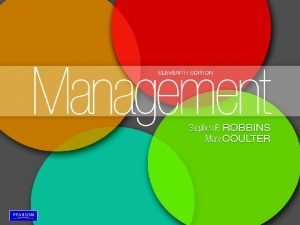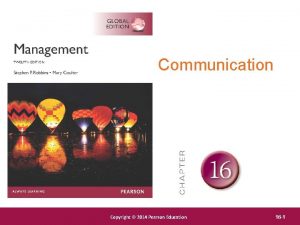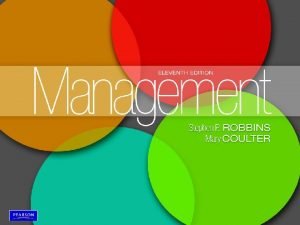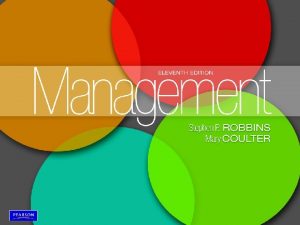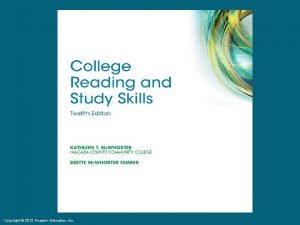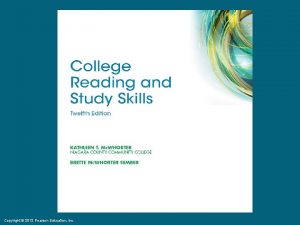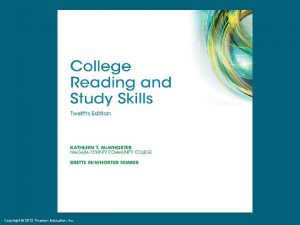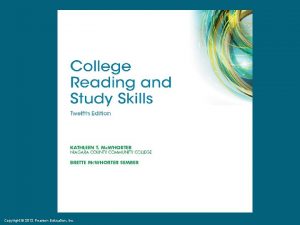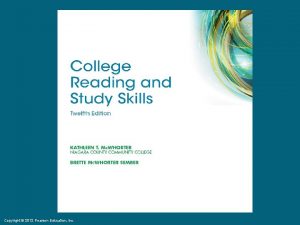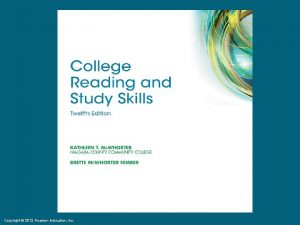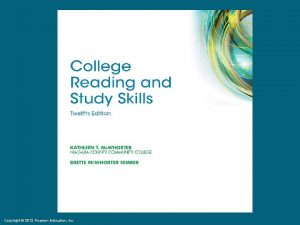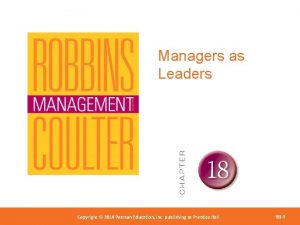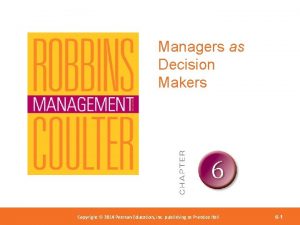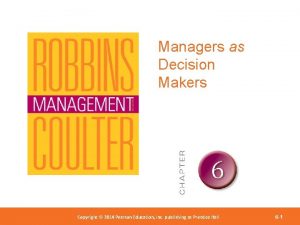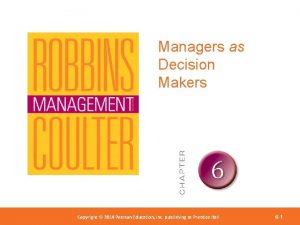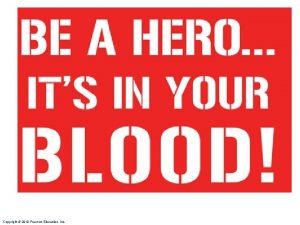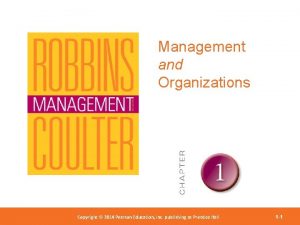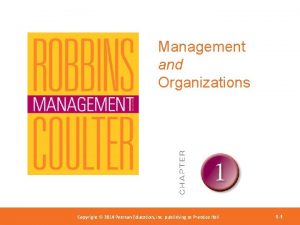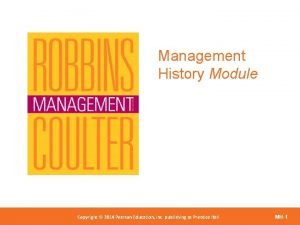Managers and Communication Copyright 2012 Pearson Education Copyright























- Slides: 23

Managers and Communication Copyright 2012 Pearson Education, Copyright © 2014 Pearson©Education, Inc. publishing as Prentice Hall Inc. Publishing as Prentice Hall 16 -1

What Is Communication? • Communication - the transfer and understanding of meaning. – Transfer means the message was received in a form that can be interpreted by the receiver. – Understanding the message is not the same as the receiver agreeing with the message. Copyright 2012 Pearson Education, Copyright © 2014 Pearson©Education, Inc. publishing as Prentice Hall Inc. Publishing as Prentice Hall 16 -2

What Is Communication? (cont. ) • Interpersonal Communication communication between two or more people. • Organizational Communication - all the patterns, networks, and systems of communications within an organization. Copyright 2012 Pearson Education, Copyright © 2014 Pearson©Education, Inc. publishing as Prentice Hall Inc. Publishing as Prentice Hall 16 -3

Functions of Communication • Control – Formal and informal communications act to control individuals’ behaviors in organizations. • Motivation – Communications clarify for employees what is to be done, how well they have done it, and what can be done to improve performance. Copyright 2012 Pearson Education, Copyright © 2014 Pearson©Education, Inc. publishing as Prentice Hall Inc. Publishing as Prentice Hall 16 -4

Methods of Interpersonal Communication • Message - a purpose to be conveyed. • Encoding - converting a message into symbols. • Channel - the medium a message travels along. • Decoding - retranslating a sender’s message. Copyright 2012 Pearson Education, Copyright © 2014 Pearson©Education, Inc. publishing as Prentice Hall Inc. Publishing as Prentice Hall 16 -5

Methods of Interpersonal Communication (cont. ) • Communication process - the seven elements involved in transferring meaning from one person to another. • Noise - any disturbances that interfere with the transmission, receipt, or feedback of a message. Copyright 2012 Pearson Education, Copyright © 2014 Pearson©Education, Inc. publishing as Prentice Hall Inc. Publishing as Prentice Hall 16 -6

Interpersonal Communication Process Copyright 2012 Pearson Education, Copyright © 2014 Pearson©Education, Inc. publishing as Prentice Hall Inc. Publishing as Prentice Hall 16 -7

Email or Print Communication: • Nonverbal communication transmitted without words. • Body language - gestures, facial configurations, and other body movements that convey meaning. • Verbal intonation - an emphasis given to words or phrases that conveys meaning. Copyright 2012 Pearson Education, Copyright © 2014 Pearson©Education, Inc. publishing as Prentice Hall Inc. Publishing as Prentice Hall 16 -8

Comparison of Communication Methods Copyright 2012 Pearson Education, Copyright © 2014 Pearson©Education, Inc. publishing as Prentice Hall Inc. Publishing as Prentice Hall 16 -9

Comparison of Communication Methods (cont. ) Copyright 2012 Pearson Education, Copyright © 2014 Pearson©Education, Inc. publishing as Prentice Hall Inc. Publishing as Prentice Hall 16 -10

Comparison of Communication Methods (cont. ) Copyright 2012 Pearson Education, Copyright © 2014 Pearson©Education, Inc. publishing as Prentice Hall Inc. Publishing as Prentice Hall 16 -11

Comparison of Communication Methods (cont. ) Copyright 2012 Pearson Education, Copyright © 2014 Pearson©Education, Inc. publishing as Prentice Hall Inc. Publishing as Prentice Hall 16 -12

Barriers to Communication • Filtering - the deliberate manipulation of information to make it appear more favorable to the receiver. • Information overload - occurs when information exceeds our processing capacity. • Jargon - specialized terminology or technical language that members of a group use to communicate among themselves. Copyright 2012 Pearson Education, Copyright © 2014 Pearson©Education, Inc. publishing as Prentice Hall Inc. Publishing as Prentice Hall 16 -13

Overcoming the Barriers • Use Feedback - ask questions about a message to determine whether it was received and understood as intended • Simplify Language – consider the audience to whom the message is directed and tailor the language to them Copyright 2012 Pearson Education, Copyright © 2014 Pearson©Education, Inc. publishing as Prentice Hall Inc. Publishing as Prentice Hall 16 -14

Direction of Communication • Town hall meeting - informal public meetings where information can be relayed, issues can be discussed, or just is a way to bring employees together to celebrate accomplishments • Downward communication that flows downward from a manager to employees Copyright 2012 Pearson Education, Copyright © 2014 Pearson©Education, Inc. publishing as Prentice Hall Inc. Publishing as Prentice Hall 16 -15

Direction of Communication (cont. ) • Upward communication - communication that flows upward from employees to managers. • Lateral communication - communication that takes place among any employees on the same organizational level. • Diagonal communication that cuts across work areas and organizational levels. Copyright 2012 Pearson Education, Copyright © 2014 Pearson©Education, Inc. publishing as Prentice Hall Inc. Publishing as Prentice Hall 16 -16

Organizational Communication Networks • Communication Networks - the variety of patterns of vertical and horizontal flows of organizational communication. • Grapevine - the informal organizational communication network. Copyright 2012 Pearson Education, Copyright © 2014 Pearson©Education, Inc. publishing as Prentice Hall Inc. Publishing as Prentice Hall 16 -17

Organizational Communication Networks Copyright 2012 Pearson Education, Copyright © 2014 Pearson©Education, Inc. publishing as Prentice Hall Inc. Publishing as Prentice Hall 16 -18

Workplace Design and Communication • Open workplaces with few physical barriers and enclosures. Copyright 2012 Pearson Education, Copyright © 2014 Pearson©Education, Inc. publishing as Prentice Hall Inc. Publishing as Prentice Hall 16 -19

Current Communication Issues • Managing Communication in an Internet World – Legal and security issues • Inappropriate use of company e-mail and instant messaging • Loss of confidential and proprietary information due to inadvertent or deliberate dissemination or to hackers – Lack of personal interaction • Being connected is not the same as face-to-face contact • Difficulties occur in achieving understanding and collaboration in virtual environments Copyright 2012 Pearson Education, Copyright © 2014 Pearson©Education, Inc. publishing as Prentice Hall Inc. Publishing as Prentice Hall 16 -20

Communication and Customer Service • Communicating Effectively with Customers – Recognize three components of the customer service delivery process: • The customer • The service organization • The service provider – Develop a strong service culture focused on the personalization of service to each customer. • Listen and respond to the customer. • Provide access to needed service information. Copyright 2012 Pearson Education, Copyright © 2014 Pearson©Education, Inc. publishing as Prentice Hall Inc. Publishing as Prentice Hall 16 -21

Getting Employee Input • In today’s challenging environment, companies need to get input from their employees • Suggestion Boxes - managers do business in a world today where you can’t afford to ignore such potentially valuable information Copyright 2012 Pearson Education, Copyright © 2014 Pearson©Education, Inc. publishing as Prentice Hall Inc. Publishing as Prentice Hall 16 -22

How to Let Employees Know Their Input Matters Copyright 2012 Pearson Education, Copyright © 2014 Pearson©Education, Inc. publishing as Prentice Hall Inc. Publishing as Prentice Hall 16 -23
 Anterior posterior ventral dorsal
Anterior posterior ventral dorsal 2012 pearson education inc anatomy and physiology
2012 pearson education inc anatomy and physiology Pearson education 2012
Pearson education 2012 2012 pearson education inc
2012 pearson education inc Pearson education inc. 2012
Pearson education inc. 2012 2012 pearson education inc
2012 pearson education inc Pearson education inc. 2012
Pearson education inc. 2012 Pearson education inc. 2012
Pearson education inc. 2012 2012 pearson education inc
2012 pearson education inc 2012 pearson education inc
2012 pearson education inc 2012 pearson education inc
2012 pearson education inc 2012 pearson education inc
2012 pearson education inc Pearson education 2012
Pearson education 2012 Pearson education inc. 2012
Pearson education inc. 2012 2012 pearson education inc
2012 pearson education inc 2012 pearson education inc
2012 pearson education inc 2012 pearson education inc
2012 pearson education inc Pearson education inc. 2012
Pearson education inc. 2012 Pearson education inc all rights reserved
Pearson education inc all rights reserved Pearson education 2011
Pearson education 2011 Pearson education inc publishing as pearson prentice hall
Pearson education inc publishing as pearson prentice hall Pearson education inc publishing as pearson prentice hall
Pearson education inc publishing as pearson prentice hall 2008 pearson prentice hall inc
2008 pearson prentice hall inc 2017 pearson education ltd
2017 pearson education ltd

